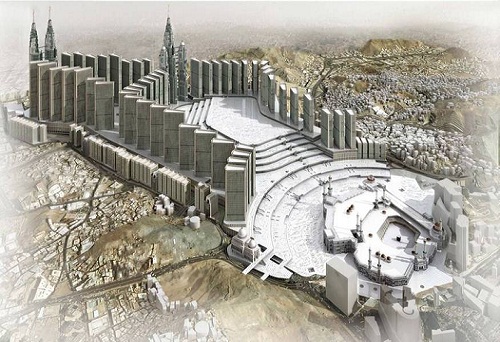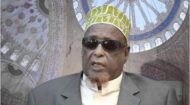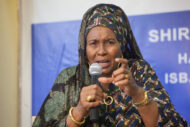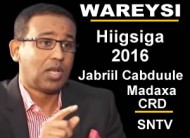Madinah Haram Mosque After Four Years
Medina`s authorities are building a mosque so big it will hold 1.6m people – but demolishing irreplaceable monuments to do it. Jerome Taylor reports
Three of the world`s oldest mosques are about to be destroyed as Saudi Arabia embarks on a multi-billion-pound expansion of Islam`s second holiest site. Work on the Masjid an-Nabawi in Medina, where the Prophet Mohamed is buried, will start once the annual Hajj pilgrimage ends next month. When complete, the development will turn the mosque into the world`s largest building, with the capacity for 1.6 million worshippers.
But concerns have been raised that the development will see key historic sites bulldozed. Anger is already growing at the kingdom`s apparent disdain for preserving the historical and archaeological heritage of the country`s holiest city, Mecca. Most of the expansion of Masjid an-Nabawi will take place to the west of the existing mosque, which holds the tombs of Islam`s founder and two of his closest companions, Abu Bakr and Umar.
Just outside the western walls of the current compound are mosques dedicated to Abu Bakr and Umar, as well as the Masjid Ghamama, built to mark the spot where the Prophet is thought to have given his first prayers for the Eid festival. The Saudis have announced no plans to preserve or move the three mosques, which have existed since the seventh century and are covered by Ottoman-era structures, or to commission archaeological digs before they are pulled down, something that has caused considerable concern among the few academics who are willing to speak out in the deeply authoritarian kingdom.
“No one denies that Medina is in need of expansion, but it`s the way the authorities are going about it which is so worrying,” says Dr Irfan al-Alawi of the Islamic Heritage Research Foundation. “There are ways they could expand which would either avoid or preserve the ancient Islamic sites but instead they want to knock it all down.” Dr Alawi has spent much of the past 10 years trying to highlight the destruction of early Islamic sites.
With cheap air travel and booming middle classes in populous Muslim countries within the developing world, both Mecca and Medina are struggling to cope with the 12 million pilgrims who visit each year – a number expected to grow to 17 million by 2025. The Saudi monarchy views itself as the sole authority to decide what should happen to the cradle of Islam. Although it has earmarked billions for an enormous expansion of both Mecca and Medina, it also sees the holy cities as lucrative for a country almost entirely reliant on its finite oil wealth.
Heritage campaigners and many locals have looked on aghast as the historic sections of Mecca and Medina have been bulldozed to make way for gleaming shopping malls, luxury hotels and enormous skyscrapers. The Washington-based Gulf Institute estimates that 95 per cent of the 1,000-year-old buildings in the two cities have been destroyed in the past 20 years.
In Mecca, the Masjid al-Haram, the holiest site in Islam and a place where all Muslims are supposed to be equal, is now overshadowed by the Jabal Omar complex, a development of skyscraper apartments, hotels and an enormous clock tower. To build it, the Saudi authorities destroyed the Ottoman era Ajyad Fortress and the hill it stood on. Other historic sites lost include the Prophet`s birthplace – now a library – and the house of his first wife, Khadijah, which was replaced with a public toilet block.
Neither the Saudi Embassy in London nor the Ministry for Foreign Affairs responded to requests for comment when The Independent contacted them this week. But the government has previously defended its expansion plans for the two holy cities as necessary. It insists it has also built large numbers of budget hotels for poorer pilgrims, though critics point out these are routinely placed many miles away from the holy sites.
Until recently, redevelopment in Medina has pressed ahead at a slightly less frenetic pace than in Mecca, although a number of early Islamic sites have still been lost. Of the seven ancient mosques built to commemorate the Battle of the Trench – a key moment in the development of Islam – only two remain. Ten years ago, a mosque which belonged to the Prophet`s grandson was dynamited. Pictures of the demolition that were secretly taken and smuggled out of the kingdom showed the religious police celebrating as the building collapsed.
The disregard for Islam`s early history is partly explained by the regime`s adoption of Wahabism, an austere and uncompromising interpretation of Islam that is vehemently opposed to anything which might encourage Muslims towards idol worship.
In most of the Muslim world, shrines have been built. Visits to graves are also commonplace. But Wahabism views such practices with disdain. The religious police go to enormous lengths to discourage people from praying at or visiting places closely connected to the time of the Prophet while powerful clerics work behind the scenes to promote the destruction of historic sites.
Dr Alawi fears that the redevelopment of the Masjid an-Nabawi is part of a wider drive to shift focus away from the place where Mohamed is buried. The spot that marks the Prophet`s tomb is covered by a famous green dome and forms the centrepiece of the current mosque. But under the new plans, it will become the east wing of a building eight times its current size with a new pulpit. There are also plans to demolish the prayer niche at the centre of mosque. The area forms part of the Riyadh al-Jannah (Garden of Paradise), a section of the mosque that the Prophet decreed especially holy..
“Their excuse is they want to make more room and create 20 spaces in a mosque that will eventually hold 1.6 million,” says Dr Alawi. “It makes no sense. What they really want is to move the focus away from where the Prophet is buried.”
A pamphlet published in 2007 by the Ministry of Islamic Affairs – and endorsed by the Grand Mufti of Saudi Arabia, Abdulaziz al Sheikh – called for the dome to be demolished and the graves of Mohamed, Abu Bakr and Umar to be flattened. Sheikh Ibn al-Uthaymeen, one of the 20th century`s most prolific Wahabi scholars, made similar demands.
“Muslim silence over the destruction of Mecca and Medina is both disastrous and hypocritical,” says Dr Alawi. “The recent movie about the Prophet Mohamed caused worldwide protests… and yet the destruction of the Prophet`s birthplace, where he prayed and founded Islam has been allowed to continue without any criticism.”
Mecca and Medina in Numbers
12m – The number of people who visit Mecca and Medina every year
3.4m – The number of Muslims expected to perform Hajj (pilgrimage) this year
60,000 – The current capacity of the Masjid an-Nabawi mosque
1.6m – The projected capacity of the mosque after expansion
© 2012. Independent Print Ltd. All Rights Reserved.
Muslim World Stunned By S. Arabia`s Plan To Destroy Prophet`s Mosque
Fars News Agency
Saturday, October 27, 2012


Haram Mosque will Look Like This After Three Years
TEHRAN (FNA)- The Saudi government plans to demolish Islamic sites, including Prophet Mohammad (PBUH)`s Mosque, taking a bulldozer to Islam`s history and divine values.
Saudi Arabia plans to destroy three of the world`s oldest mosques in a multi-billion-pound expansion of Islam`s second holiest site, a plan which has shocked the Muslim community worldwide, Independent said.
Work on the Masjid an-Nabawi in Medina, where the Prophet Mohammad (PBUH) is buried, will start once the annual Hajj pilgrimage ends next month. When complete, the development will turn the mosque into the world`s largest building, with the capacity for 1.6 million people.
But the Saudi plan to raze Islam`s historical and most revered sites has stunned the Muslim world. Saudi King Abdullah`s apparent disdain for preserving historical and archeological heritage of Mecca, the holiest city in the country and the world of Islam, has already fueled outrage.
Most of the expansion of Masjid an-Nabawi will take place to the West of the existing mosque, which holds the tombs of Islam`s founder and the first two Caliphs of Sunni Islam, Abu Bakr and Omar.
Also Saudi Ministry of Islamic Affairs published a pamphlet in 2007 prepared by the Grand Mufti of Saudi Arabia, Abdulaziz al Sheikh who called for destruction of the mosque`s dome and flattening the graves of Prophet Mohammad (PBUH), Abu Bakr and Omar.
Dr. Irfan al-Alawi of the Islamic Heritage Research Foundation who has spent much of his past 10 years activities on highlighting the destruction of early Islamic sites said, “Muslim silence over the destruction of Mecca and Medina is both disastrous and hypocritical.”
“The recent movie about the Prophet Mohammad (PBUH) caused worldwide protests… and yet the destruction of the Prophet`s birthplace, where he prayed and founded Islam has been allowed to continue without any criticism,” he added.
(Description of Source: Tehran Fars News Agency in English — hardline semi-official news agency, headed as of 24 July 2011 by Nezameddin Musavi; //www.english.farsnews.com)
© Compiled and distributed by NTIS, US Dept. of Commerce. All rights reserved.
Makkah to have 100 new towers
Distributed by Contify.com
UAE Government News
October 23, 2012


A big housing project started near the Holy Haram
The holiest city of Islam Makkah is currently going through a host of infrastructure and developmental progress and set to have 100 new multi-storey towers worth SR18 billion near the Grand Mosque, media reports said.
Once all the ongoing constructions get completed the Holy City will be ready to offer more than 24,480 hotel rooms to the hospitality industry, according to industry expert.
The Saudi Arab government is pouring billions of riyals for developing the infrastructure and hospitality sector which is boosting the construction sector a great deal and is resulting into the prosperity of the Kingdom`s hospitality industry.
Moreover, the ongoing capacity expansion of the King Abdul Aziz InternationalAirport in Jeddah is set to fuel the boom in the hospitality and tourism industry. The airport`s expansion project seek to take annual passenger handling capacity from current levels of 12 million to 14 million, media reports said.
© Copyright 2012 Contify.com
Article Accuses Saudi regime of Politicizing Pilgrimage
Al-Quds al-Arabi Online
Sunday, December 21, 2008


A Muslim pilgrim looks at a jewellery shop a prayer session at the surrounding area of the Grand Mosque during the annual hajj pilgrimage in the holy city of Mecca October 20, 2012. They might wear the humble white sheets required for Islam`s haj pilgrimage, but for many visitors thronging Mecca`s streets, the perfect souvenir of their trip is that most glittering of commodities: gold. For most pilgrims haj represents the fulfilment of a lifelong ambition and many of them want to commemorate their journey with keepsakes or gifts for relatives that carry a special religious significance. Picture taken October 20, 2012. REUTERS/Amr Abdallah Dalsh
Commentary by Madawi al-Rashid:”The Hajj: The Festival of a Policy in Crisis”
The hajj, the fifth pillar of Islam, has turned into a media and political festival that reflects the predicament of the Saudi leadership, which adopts the motto of custodianship of the Two Holy Mosques.
We need to admit that the political leadership that exercises hegemony over the Muslim people`s places of worship bears a huge responsibility dictated by geographical realities, political obligations, and religious duty towards the Muslim Qibla, the destination of their annual pilgrimage and their visits outside the season of the major pilgrimage.
Regrettably the hajj has turned into a political festival that the Saudi leadership exploits to establish an Islamic legitimacy that extends beyond the borders of the Saudi state. The hajj season is utilized as a stage on whichSaudi Arabia parades its charitable largesse and its expenditure to develop and expand the holy sites in the service of the global Islamic public. It acts as if it is giving a gift to the Muslim world out of its own pockets by expanding the Great Mosque to enable it to accommodate a greater number of pilgrims. It forgets, meanwhile, that it is responsible not only for disfiguring holy Mecca`s ground space but also its skyline by building high rise hotels, gigantic billboards, and buildings with a foreign character and design that are not appropriate for the city`s sacredness, spiritual atmosphere or religious aim. The expansion projects and the demolition of historical buildings and their replacement with touristic establishments from which ordinary Muslims cannot benefit because of the exorbitant costs of staying at them remain the exclusive province of the Saudi leadership itself, its institutions, and diplomatic corps. As a result these projects are a subject of controversy. They are rejected by Mecca`s inhabitants and other Muslims alike. Additionally the Saudi leadership plays the role of the gatekeeper who keeps out undesirable pilgrims under the pretext of so-called quotas.
According to this quota system every Muslim country is allotted a certain number of pilgrims each year. The system allows for the exclusion of those who are unwanted. Most exceptions depend on the nature of the country in question`s relationship with Saudi Arabia in any particular year. This selective process affects not only Muslims who come from countries classified as troublesome in the Saudi lexicon but also Saudi nationals living abroad, especially those who support the opposition. We can state with certainty that all the Saudi oppositionists who reside in Britain and whose Saudi passports have been withdrawn will never be able to apply for Saudi visas to perform the pilgrimage. Add to these a large segment of Muslims who are known to harbor ideas opposed to the Saudi regime`s policies. Saudi Arabia also punishes other Muslim communities by obstructing their travel to Mecca. The recent uproar over the Gaza Strip`s pilgrims was just another episode of the cycles of exclusions to which Iranian and Iraqi pilgrims were subjected in the past.
Saudi Arabia adopts and promotes a religious discourse that denies the sacred character of Muslim sites in other countries. It tries to confine the character of sacredness to Mecca alone although Mecca does not admit all the pilgrims that wish to visit it during the hajj season. Although Mecca continues to assume the position of the primary holy place, there are other Muslim sites that are of great significance including Jerusalem, to which the Saudi leadership does not attach the same political weight although its religious importance is known to everyone. Yes, Mecca remains the primary hajj destination for an important pillar of Islam, but the Muslim people`s current and past aspirations to visit other sacred sites was dictated by Islam`s religious development of the past few centuries. These places have grown and developed in a progressive manner and their visitors found in them a spiritual experience that might not replace the pilgrimage to Mecca but at the same time complements and enriches it. Saudi Arabia does not only deny the importance of the other sacred Muslim sites but actively denounces the act of carrying out pilgrimage to them. At the same time, it practices a process of selection of all those who wish to visit Mecca under the guise of ensuring services to them and the limits of Mecca and Medina`s accommodation capacities.
Under the shadow of the Saudi leadership the hajj turned into a purging process by which this leadership aims to clear the Islamic religion from impurities that the Saudi religious bureaucracy considers forms of disbelief and idolatry. The Saudi leadership has gone to such lengths in pursuing this objective that the hajj has turned into a trip fraught with risk and fear of the censor`s whip who has installed himself as purger of Islam and the Muslim people. Many pilgrims documented their hajj experiences in books and treatises including the well-known Moroccan anthropologist Abdullah Hmoudi and the Pakistani Dr Kanta Ahmad. Both books tell of their authors` cruel experiences that were nothing like what you expect from a trip by which a pilgrim grows closer to his God.
We wish to ask why those writers and others like them did not thank the Saudi leadership for disfiguring Mecca`s ground space. We wish to ask why they did not thank it for the appallingly deficient hygienic services and the huge mounds of garbage they saw around the places where they were staying. We wish to ask why those persons did not purify their Islam of the innovations they learned in their home countries and did not adopt the Saudi form of Islam, thus denying the special characteristics of their own countries `rites of worship which they learned in their youth. We wish to ask why the Saudi authorities did not hand over to them the bodies of their blood relatives who died during previous hajj seasons. Indeed some of them have been waiting for more than 29 years to learn the circumstances of the death of a father, brother, or sister.
Many Muslims ask questions about Saudi Arabia`s hajj arrangements and its hegemony over this religious experience to which millions aspire, many of whom die before they can carry it out. If the number of pilgrims is the problem, we should bear in mind that the pilgrimage sites of other religions like Hinduism, for example, admit during certain seasons a number of pilgrims that is several times larger than the number of hajjs who visit Mecca. Even outside the sphere of religion, keep in mind that some train stations in major industrial cities handle millions of passengers and commuters daily.
In case catastrophes occur during the hajj season, Saudi Arabia and its spokesmen have ready statements blaming the hajjs themselves, their ignorance, and backwardness. These statements reveal the overbearing attitude of superiority of Saudi officialdom in its ugliest forms especially when they use phrases and terms that are insulting to some of the Muslim world`s poorest populations who do not travel for entertainment but spend their entire life savings to visit a place of pilgrimage for God`s pleasure.
When the Saudi leadership turned the hajj season into apolitical festival that begs legitimacy from the Muslims, it opened the door wide to nonsensical political talk and the exchange of accusations among millions of Muslims who yearn for the chance of making the pilgrimage once in their lives. Instead of continuing to exploit the hajj in this ugly manner, the Saudi leadership would do better to turn the hajj arrangements and supervision over to a higher committee composed of representatives of the concerned Muslim countries but it could continue to foot the bill for the hajj, not because it is a rich country but because it markets itself as custodian of the Two Holy Mosques. It is Saudi Arabia`s responsibility, since Mecca and Medina are located within its internationally recognized borders, to shoulder the concomitant financial and religious responsibility because it also profits from this religious occasion which, before the oil era, was its primary source of income, which the leadership appropriated for its own good and the good of the merchants, guides, and hotel owners who were associated with its bureaucracy. The Islamic world is tired of the seasonal exploitation of the hajj and turning this religious rite into a ball game between Saudi Arabia and other political forces that wish to settle political accounts with it.
The Islamic world`s fragmentation, combined with the dazzle of Saudi wealth, has blinded many people to the real nature of the annual political festival and the accompanying Saudi media campaign that is designed to exploit and mislead. Even if some Muslims criticize certain Saudi shortcomings, they do not do this out of ingratitude or the wish to deny Saudi largesse. Their criticism stems from their recognition of the host country`s responsibility for the hajj and their annoyance at Saudi Arabia`s ostentatious show of generosity. Let those who supervise the hajj affairs understand that this is not an economic development project, an industrial zone, a process of purging the Muslim people`s religious beliefs and rites of impurities, or even a desperate attempt to obliterate important geographical landmarks from the Muslim nations` collective memory after Saudi Arabia destroyed them under the guise of fighting idolatry, expanding the holy sites to accommodate more pilgrims, or to excise from the collective Muslim memory historical Mecca sites that modern Saudi Arabia demolished.
Everyone knows that Mecca`s history did not begin in 1932.(year when King Abd-al-Aziz Al Sa`ud captured the city) Responsibility for remembering Mecca`s earlier history lies with its inhabitants for they know the story but have regrettably surrendered to the Saudi demolisher. As to the rest of the Muslims, they have been blinded by Saudi money and excel at begging from and submitting to Saudi Arabia. The price for this state of affairs is paid by the ordinary Muslim pilgrims who are unable to take up stands that might hinder their hajj visa applications that they have to submit to the manipulative self-appointed guardian of Islam. When Saudi Arabia turned the hajj into the political festival of a country in a state of crisis, it opened the door wide to mutual recriminations. We can only blame the party that started the whole thing.
(Description of Source: London Al-Quds al-Arabi Online in Arabic — Website of London-based independent Arab nationalist daily with strong anti-US bias. URL: //www.alquds.co.uk/)
© Compiled and distributed by NTIS, US Dept. of Commerce. All rights reserved.

 All Posts
All Posts










